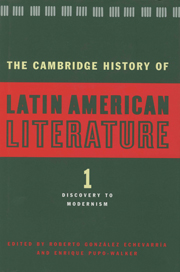Book contents
- Frontmatter
- Introduction to Volume 1
- 1 A brief history of the history of Spanish American Literature
- 2 Cultures in contact: Mesoamerica, the Andes, and the European written tradition
- 3 The first fifty years of Hispanic New World historiography: the Caribbean, Mexico, and Central America
- 4 Historians of the conquest and colonization of the New World: 1550–1620
- 5 Historians of the colonial period: 1620–1700
- 6 Colonial lyric
- 7 Epic poetry
- 8 Spanish American theatre of the colonial period
- 9 Viceregal culture
- 10 The eighteenth century: narrative forms, scholarship, and learning
- 11 Lyric poetry of the eighteenth and nineteenth centuries
- 12 Spanish American theatre of the eighteenth century
- 13 The nineteenth-century Spanish American novel
- 14 The brief narrative in Spanish America: 1835–1915
- 15 The Spanish American theatre of the nineteenth century
- 16 The essay in Spanish South America: 1800 to Modernismo
- 17 The essay of nineteenth-century Mexico, Central America, and the Caribbean
- 18 The gaucho genre
- Index
- Bibliographies
- References
8 - Spanish American theatre of the colonial period
Published online by Cambridge University Press: 28 March 2008
- Frontmatter
- Introduction to Volume 1
- 1 A brief history of the history of Spanish American Literature
- 2 Cultures in contact: Mesoamerica, the Andes, and the European written tradition
- 3 The first fifty years of Hispanic New World historiography: the Caribbean, Mexico, and Central America
- 4 Historians of the conquest and colonization of the New World: 1550–1620
- 5 Historians of the colonial period: 1620–1700
- 6 Colonial lyric
- 7 Epic poetry
- 8 Spanish American theatre of the colonial period
- 9 Viceregal culture
- 10 The eighteenth century: narrative forms, scholarship, and learning
- 11 Lyric poetry of the eighteenth and nineteenth centuries
- 12 Spanish American theatre of the eighteenth century
- 13 The nineteenth-century Spanish American novel
- 14 The brief narrative in Spanish America: 1835–1915
- 15 The Spanish American theatre of the nineteenth century
- 16 The essay in Spanish South America: 1800 to Modernismo
- 17 The essay of nineteenth-century Mexico, Central America, and the Caribbean
- 18 The gaucho genre
- Index
- Bibliographies
- References
Summary
Historical survey
The sixteenth and seventeenth centuries witnessed a robust and diverse theatrical tradition in the Spanish American colonies. The main component of that tradition, both formally and ideologically, was the Hispanic; most of the theatre written in Spain’s New World possessions resembled that of the Motherland. This is not to say, however, that colonial theatre was merely derivative: variations of cultural context and creative disposition ensured it had a distinctive character. Moreover, the influence of indigenous modes of dramatic representation was significant, especially in the sixteenth century. Theatre in the Nahuatl and Quechua languages continued to be composed and performed in the seventeenth century, sometimes coexisting, sometimes commingling with Spanish dramatic themes, dramatic forms, and the Spanish language itself.
The legacy of indigenous theatre
All evidence suggests that theatre, in its broadest sense, was deeply embedded in the consciousness of the native peoples of what was to become Spanish America. The Spanish chroniclers of the period of discovery and conquest testify to the presence of theatres and dramatic spectacles – “farsas” “entremeses” – among the conquered peoples. What is more, their accounts of the manifold aspects of indigenous life and society indicate that dramatic representation was intimately linked with a full array of cultural phenomena. More than diversion from everyday life, such representation was, for the indigenous populations, an organic part of that life. It gave collective expression to their guiding ideologies – dynastic, theogonic, telluric, and so on – and helped to preserve cultural history and identity in societies for whom writing was either unknown or limited to an elite.
- Type
- Chapter
- Information
- The Cambridge History of Latin American Literature , pp. 260 - 285Publisher: Cambridge University PressPrint publication year: 1996
References
- 1
- Cited by



